PostgreSQL RANK Function
Summary: in this tutorial, you will learn how to use PostgreSQL RANK() function to assign a rank for every row of a result set.
Introduction to PostgreSQL RANK() function
The RANK() function assigns a rank to every row within a partition of a result set.
For each partition, the rank of the first row is 1. The RANK() function adds the number of tied rows to the tied rank to calculate the rank of the next row, so the ranks may not be sequential. In addition, rows with the same values will get the same rank.
The following illustrates the syntax of the RANK() function:
RANK() OVER (
[PARTITION BY partition_expression, ... ]
ORDER BY sort_expression [ASC | DESC], ...
)In this syntax:
- First, the
PARTITION BYclause distributes rows of the result set into partitions to which theRANK()function is applied. - Then, the
ORDER BYclause specifies the order of rows in each a partition to which the function is applied.
The RANK() function can be useful for creating top-N and bottom-N reports.
PostgreSQL RANK() function demo
First, create a new table named ranks that contains one column:
CREATE TABLE ranks (
c VARCHAR(10)
);Second, insert some rows into the ranks table:
INSERT INTO ranks(c)
VALUES('A'),('A'),('B'),('B'),('B'),('C'),('E');Third, query data from the ranks table:
SELECT
c
FROM
ranks;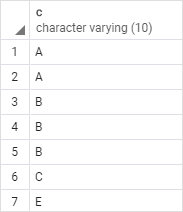 Fourth, use the
Fourth, use the RANK() function to assign ranks to the rows in the result set of ranks table:
SELECT
c,
RANK () OVER (
ORDER BY c
) rank_number
FROM
ranks;The following picture shows the output:
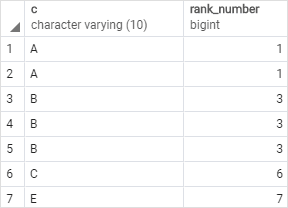 As you can see clearly from the output:
As you can see clearly from the output:
- The first and second rows receive the same rank because they have the same value
A. - The third, fourth, and fifth rows receive the rank 3 because the
RANK()function skips the rank 2 and all of them have the same valuesB.
PostgreSQL RANK() function examples
We’ll use the products table to demonstrate the RANK() function:
 This picture shows the data of the
This picture shows the data of the products table:
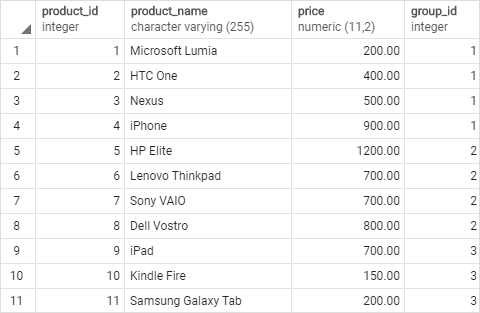
1) Using PostgreSQL RANK() function for the whole result set
This example uses the RANK() function to assign a rank to each product by its price:
SELECT
product_id,
product_name,
price,
RANK () OVER (
ORDER BY price DESC
) price_rank
FROM
products;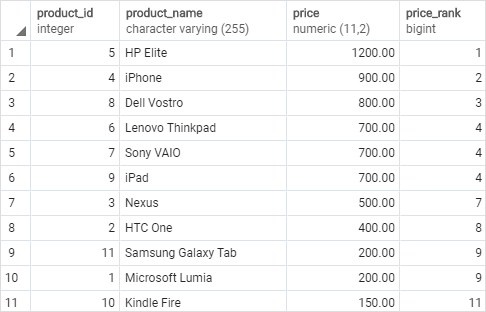 In this example, we omitted the
In this example, we omitted the PARTITION BY clause, therefore, the RANK() function treated the whole result set as a single partition.
The RANK() function calculated a rank for each row within the whole result set sorted by prices from high to low.
2) Using PostgreSQL RANK() function with PARTITION BY clause example
The following example uses the RANK() function to assign a rank to every product in each product group:
SELECT
product_id,
product_name,
group_name,
price,
RANK () OVER (
PARTITION BY p.group_id
ORDER BY price DESC
) price_rank
FROM
products p
INNER JOIN product_groups g
ON g.group_id = p.group_id;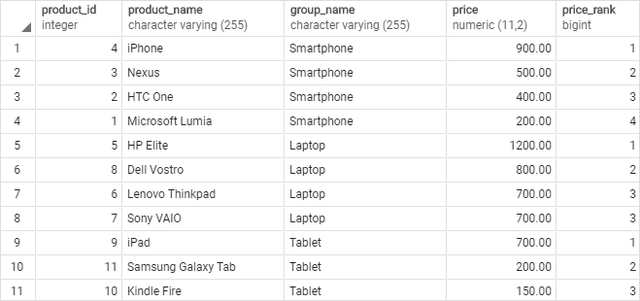 In this example:
In this example:
- First, the
PARTITION BYclause distributes products into partitions grouped by product group id (group_id). - Second, the
ORDER BYclause sort products in each partition by their prices from high to low.
The RANK() function was applied to every product in each product group and it is reinitialized when the product group changed.
In this tutorial, you have learned how to use the PostgreSQL RANK() function to calculate a rank for every row in a partition of a result set.